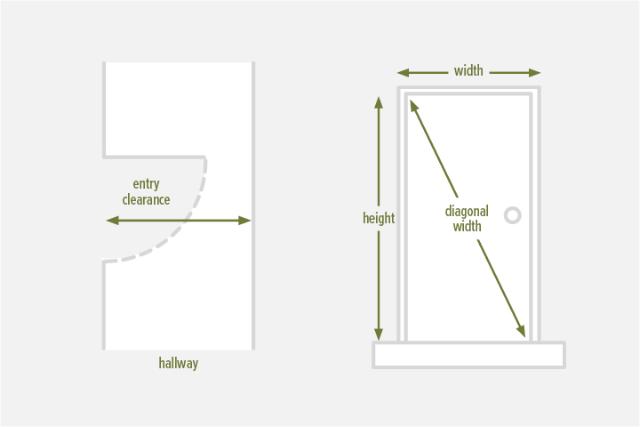
Bring it In: Getting Furniture Into Your Home
Before you buy furniture, make sure it will fit through your door!
There’s nothing worse than falling head over heels in love with a couch and then finding out it doesn’t fit in the room you’re looking to furnish. Actually, now that we think about it, not being able to even fit the couch through your front door might be worse! That’s why before you do anything (yes, even browsing) you’ll need to go ahead and find out which measurements you’re working with.
Don’t worry, we’re going to walk you through the process step by step.
Where Do I Start? Taking Measurements for Delivery
Start by measuring the doorway through which you will be bringing the furniture piece into your home. For most people that will be the front doorway, but depending on where you plan on placing the piece, it could also be a side or back doorway. If you live in a multifamily home such as an apartment or condo, be sure to also measure the exterior doorway to the building if there is one.
After measuring the exterior doorway, continue to then measure each doorway through which the furniture piece will pass before arriving in the room where you’d like to place it.

How Do I Measure a Doorway?
You will need the height, width and diagonal width of the doorway. Don’t panic, here’s what diagonal width means: you take this measurement from the top left to the bottom right of the doorway.
What’s Next? Don’t Forget the Stairs
Next, you’ll want to measure any stairways that you’ll need to pass through before arriving at your furniture piece’s destination. Just like with the doorway, you’ll want to measure the height, width and diagonal distance from a top corner to an opposing bottom corner. It’s this diagonal measurement that’s going to help you pivot a large box up or down the stairs if needed.

Almost Done! Just Around the Corner
Lastly, you’ll need to measure any corners (height, width and diagonal) such as those by a staircase or in a hallway (be sure to also measure the hallway itself), as well as any other details in a tight space such as how far into the room a door swings if you think it might be an impediment. Don’t forget to include details such as light fixtures (especially in or by a stairway), angled ceilings, doorknobs, railings or other structural features in your measurements.
Wait, Even the Elevator?
If you live in a multifamily home that contains an elevator, you’ll need to measure that too. Again, you’ll want to measure the height and width of the elevator doorway, and you’ll also want to measure the depth. Be sure to also measure the diagonal distance between the bottom of the elevator door once closed to the top of the opposing wall of the elevator. A furniture piece might rest diagonally in this position as you travel on the elevator.
Read here to see how you can visualize the piece in your space.

Furniture to Make Your Small Room Look Bigger
Pieces with open space, concealed storage and even mid-century modern style can make your room appear larger.

Small-Space Living Tips
Don’t let limited square footage cramp your style. Live large in your small space.

6 Tips for Making Your Living Room Cozy This Winter
Create a cozy, inviting space where you and your guests will long to linger.

Rudolph Can Run Run While You Sit Sit: Take a Break With Our Favorite Stools
The right stool can help you relax. Find your perfect perch.

Settle Down for a Long Winter’s Nap This Holiday With Our Favorite Beds
Elevate your bedroom’s aesthetic and sleep peacefully with a new bed.

Give Your Kids the Gift of Better Sleep This Holiday: Browse Our Favorite Youth Beds
This year, give your child the gift they really want: a room makeover!

Color Trends for Fall
See which colors have captured our collective imagination and inspire joy.

Back to School: How to Organize Your Child’s Bedroom
Back to school season is upon us, and that means it’s time to bring some order back into your child’s schedule … and their bedroom.

Finding the Perfect Furniture Fit
Visualize what your new furniture piece will look like in your space.

Bring it In: Getting Furniture Into Your Home
Before you buy furniture, make sure it will fit through your door!
